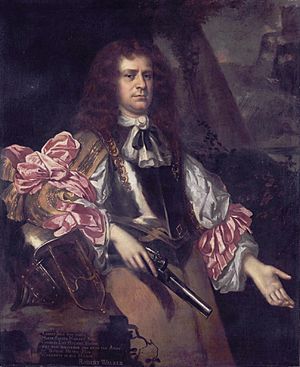George Joyce facts for kids

Lieutenant-Colonel George Joyce (born 1618) was an officer in the New Model Army during the English Civil War. He was also known as an "Agitator," which meant he spoke up for the soldiers' rights and concerns.
In June 1647, Joyce made a very important move. He took King Charles I from where Parliament was holding him at Holdenby House. Joyce then brought the King to the army's headquarters. This action made Parliament weaker and the army stronger during a tense time.
Contents
Early Life and Army Service
Before he joined the army, George Joyce worked as a tailor in London. A famous writer from that time, the Earl of Clarendon, said that Joyce also worked in a small job for a man named Mr. Holles.
By 1644, Joyce had joined the army that fought for Parliament. He was part of Oliver Cromwell's cavalry, which were nicknamed the 'Ironsides'. By 1647, he was given the rank of Cornet, which was a junior officer, in Sir Thomas Fairfax's personal guard. Fairfax later called Joyce an "Arch-Agitator" because he was so active in representing the soldiers.
Taking the King at Holdenby House
After the first part of the First English Civil War ended in 1647, Parliament wanted to break up the New Model Army. They also didn't want to pay the soldiers all the money they were owed. Because of this, Joyce was given a special task. He was to lead about 500 men to take control of King Charles I. The King was being held by Parliament at Holdenby House.
This plan might have come from a group of elected army representatives called 'Agitators'. It also seems that Oliver Cromwell quietly agreed to the plan. Cromwell later said he told Joyce to make sure the King was safe at Holdenby. However, he denied telling Joyce to move the King from there.
On June 2, Joyce and his men successfully took over Holdenby House. He soon heard that the officer guarding the King had run away. Joyce worried that this officer would return with more soldiers and take the King back. So, Joyce decided to move King Charles to Newmarket, where the New Model Army had its main camp.
In the middle of the night on June 3, Joyce went into the King's bedroom. He had a pistol with him. He told the King that he had to leave with his soldiers the next morning. As they were about to go, King Charles asked Joyce who had given him the authority to take him. Joyce simply pointed to the 500 soldiers standing behind him.
Sir Thomas Fairfax, the army's commander, said he didn't know about Joyce's actions beforehand. He wanted to put Joyce on trial by the army. But Cromwell and Henry Ireton stepped in to help Joyce. They even promised him a promotion. Fairfax eventually understood that Joyce's decision had helped the army. Joyce wrote in a letter about taking the King:
"Let the Agitators know once more we have done nothing in our own name, but what we have done has been in the name of the whole Army."
Promotions and Later Career
In early 1648, Joyce was promoted to captain. He was also made the governor of Southsea Castle, a fort.
According to an account by Sir John Berkley, Joyce believed that the King should be put on trial in 1648. He thought this would show that the Parliament side was not to blame for the war.
Joyce spoke at important army meetings in 1648 and 1649. At a meeting in Whitehall, he argued that the army, not Parliament, had the real power to make laws. He urged the main army leaders to use this power. He said that by acting as God's tools, they could "remove mountains" and do amazing things.
During the time of the Commonwealth of England (when England was a republic), Joyce became involved in buying land. He bought land that used to belong to the King, which the government had taken. By 1651, he fully owned Portland Castle.
On June 17, 1650, Joyce became the governor of the Isle of Portland. In August, he was made a lieutenant-colonel in a new army group. In October 1651, he went on a trip to take back Jersey. This trip was successful. It meant that the last place still loyal to the King in the British Isles was now under Parliament's control.
In 1653, Joyce did not agree with breaking up the Rump Parliament (the remaining part of Parliament). He wanted a fairer government to replace it. He was arrested and put in prison for a short time. This happened after he supposedly said something about Cromwell. However, Joyce said the main reason for his arrest was a disagreement over property with Richard Cromwell, Oliver Cromwell's son.
Life After the King Returned
In June 1660, the King returned to power in England. Parliament issued a warrant for Joyce's arrest. This was because someone claimed Joyce was the masked man who executed King Charles I. Because of this, Joyce escaped to Rotterdam in the Netherlands with his wife and children.
The new King's government was still worried about Joyce. State spy agencies watched him closely. In 1664, he was thought to be involved in a plan with other people who wanted a republic. They were accused of trying to raise a rebel army.
In 1670, King Charles II sent someone to Rotterdam to bring Joyce back to England. This is called extradition. However, the Dutch authorities allowed Joyce to escape. It is not known what happened to him after this time.


